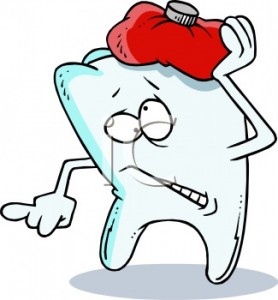 Dry socket (alveolar osteitis) is a wound healing complication that can occur following teeth extractions if the initial blood clot is lost. This results in exposed bone in the socket devoid of normal healing tissues, hence the name “dry socket.” It usually occurs three to five days after an extraction and is characterized by a sudden increase in severe and throbbing pain. Dry socket is treated by temporarily packing the site with eugenol, antibiotics, and oral rinses. As the socket forms a new layer of healing tissue, the pain gradually subsides and, finally, the socket slowly fills in over the next 2-3 months.
Dry socket (alveolar osteitis) is a wound healing complication that can occur following teeth extractions if the initial blood clot is lost. This results in exposed bone in the socket devoid of normal healing tissues, hence the name “dry socket.” It usually occurs three to five days after an extraction and is characterized by a sudden increase in severe and throbbing pain. Dry socket is treated by temporarily packing the site with eugenol, antibiotics, and oral rinses. As the socket forms a new layer of healing tissue, the pain gradually subsides and, finally, the socket slowly fills in over the next 2-3 months.
The risk for dry socket increases in patients who smoke after teeth extractions, vigorously rinse too early, spit, or use a straw to drink within the first 24 hours—all of which can disturb the initial blood clot. Another major risk factor for developing dry socket is traumatic surgical techniques, such as tearing the gum tissue, aggressive drilling of the bone, and excessive manipulation of the extraction socket, which, ultimately, results in devitalized tissue with poor blood supply.
While the possible incidence of dry socket is between 1-3%, we have experienced no dry sockets after performing more than 150,000 extractions over the past 18 years.
Here are our secrets to avoiding dry socket after teeth extractions:
•Non-traumatic surgical techniques: An experienced oral surgeon can extract teeth using non-invasive or minimally-invasive techniques. This means no gum tissue flap or minimal gum tissue flap, no removal of bone or minimal removal of bone, use of copious amounts of irrigation, gentle handling of the tissues, and removal of teeth with ease. There is an old saying, “Do less to the body, and the body will do less to you!”
•Avoid smoking following an extraction: Smoking creates suction in the mouth that can dislodge the blood clot. It also directly inhibits the normal healing physiology.
•Avoid rinsing or brushing on the evening of an extraction: Any rinsing or brushing immediately following a tooth extraction can cause loosening or dislodging of the blood clot leading to a dry socket. Do not rinse or brush until the day after the extraction. Then rinse gently for the next 1-2 days and more vigorously in the following days.
•Do not use a straw in the first 24 hours: The use of straw can also cause suction and dislodge the blood clot. To drink, simply sip from a glass.
•Do not spit: With blood and saliva accumulating in the mouth following an extraction, you may be inclined to spit it out. This action, again, can disrupt the organizing blood clot and cause it to loosen. Do not spit; instead, let the accumulated blood and saliva drool down and wipe it gently with a gauze or tissue.
•Keep biting on the gauze with firm pressure until bleeding stops: Constant and firm pressure helps to slow down bleeding following teeth extractions and stabilizes the formed blood clot. The gauze should remain in place for at least 30-45 minutes before changing it for a new one; continue using the gauze until bleeding stops completely.
See our complete post-extraction instructions & video